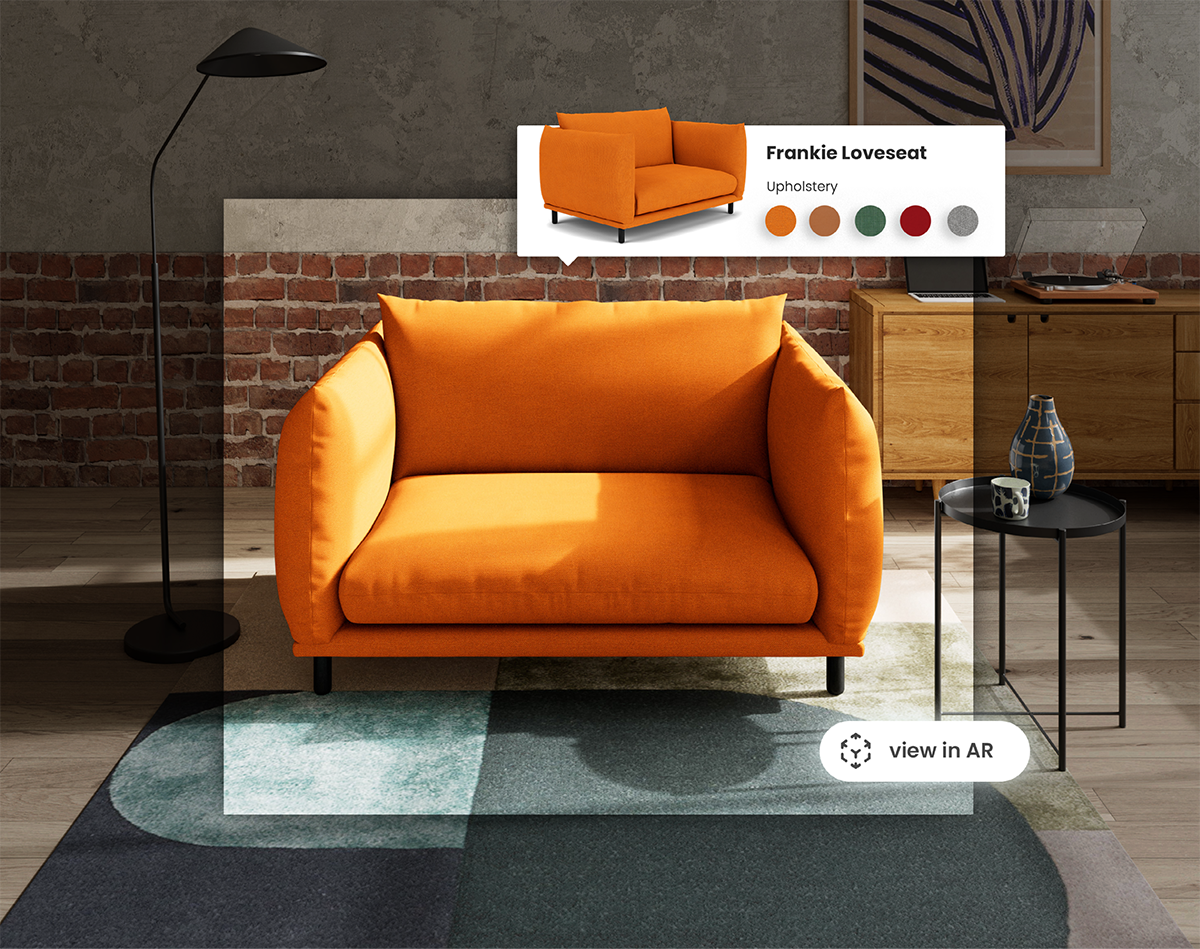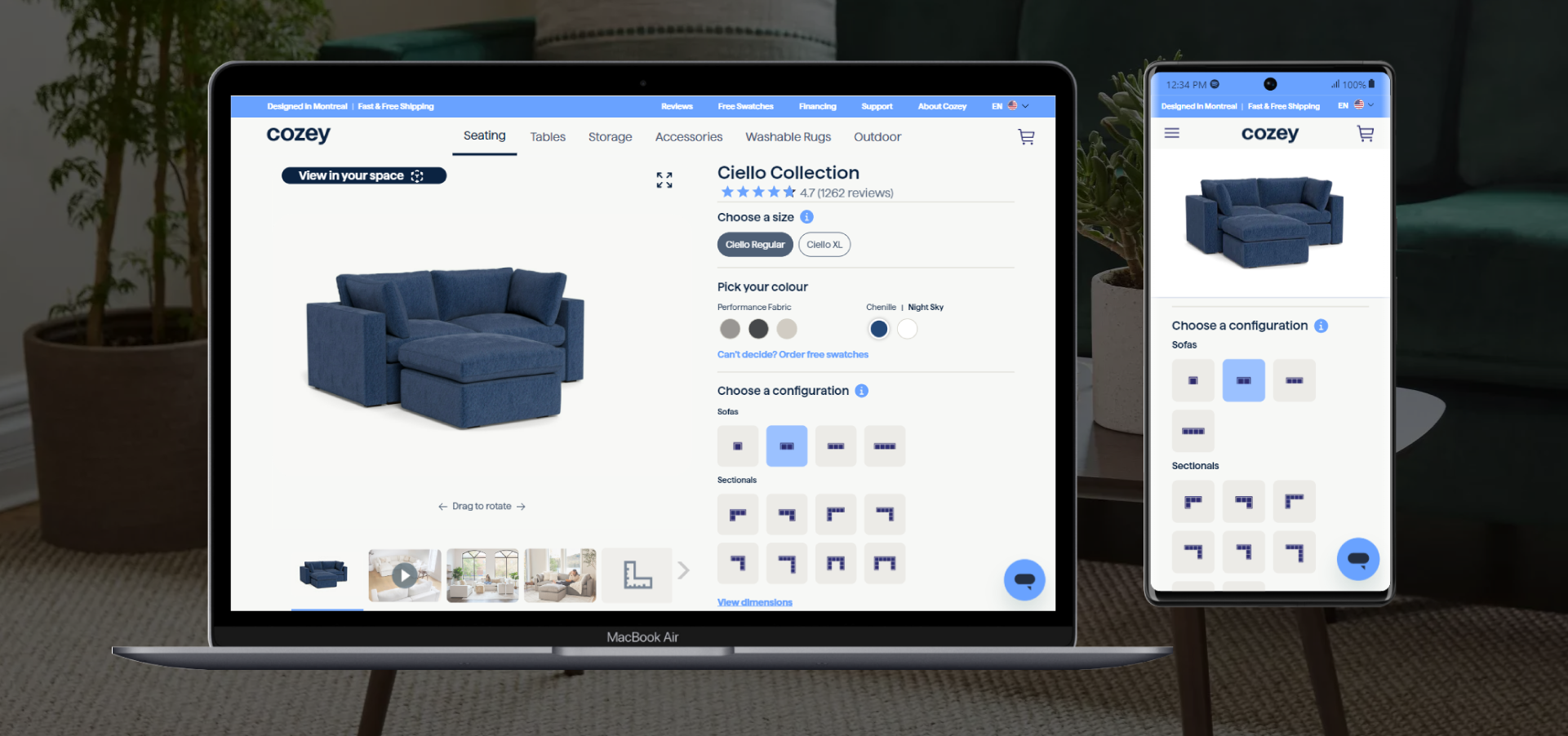With more ways to shop than ever before, furniture businesses seek tools that help them meet evolving customer expectations.
The rise of 3D commerce, mobile shopping, frictionless delivery, artificial intelligence (AI), conversational commerce, augmented reality, virtual reality, and hyper-personalized experiences is intensifying technology adoption in the furniture sector.
Despite the economic challenges, furniture businesses that embrace innovation and new technology while continuously focusing on the customer experience could ride out short-term turbulence and emerge stronger in the years to come.
Furniture e-commerce market outlook
The post-pandemic years have been challenging for the furniture industry. Interest rates and inflation have hit consumers hard. As soon as life started getting back to normal, customers returned to going to restaurants and traveling instead of investing all of their money into their homes.
But the challenges don’t end there — 2024 is the biggest election year in history, with more than half the world’s population — over four billion people voting. And we know that election years almost always bring conservative consumer attitudes toward buying.
Despite all the challenges, furniture e-commerce is still on the rise. According to Statista, in 2023, the United States was the biggest market for furniture e-commerce worldwide, with estimated revenues exceeding $90 billion. China ranked second, with furniture e-retail revenues reaching approximately 45.8 billion USD. The list of countries with the highest furniture e-commerce revenue includes Germany, Japan, the United Kingdom, and France.
That said, furniture companies have plenty of reasons to be optimistic about the future. The long-awaited generational shift is finally on the horizon. And the behavioral and spending discrepancies make this shift significant for every industry — including furniture.
Digital native generations, like millennials and Gen Zs, value experiences more than products, and they are also used to online shopping via e-commerce stores and social media. This means that furniture businesses will have to offer a delightful furniture shopping experience from start to finish — including online and offline touchpoints.
Trends for furniture e-commerce success in 2024
As companies look to the state of furniture industry in 2024 and beyond, it’s critical to know how furniture e-commerce trends influence the ways customers interact with your business in order to stand out in the competitive market. Let’s explore the key trends that will impact furniture businesses in the upcoming years.
1. 3D Commerce
3D commerce is the new way of shopping powered by the use of 3D product visualization, visual product configuration, and augmented reality to deliver an enhanced online shopping experience.
We are living in the decade of 3D commerce. Having high-quality 3D visualization on your product details page is table stakes nowadays — but 3D visualization goes way beyond that, and we’ll see a large increase in the number of use cases where retailers and brands leverage 3D furniture visualization to create a better customer experience and ultimately better conversions.
3D visualization is reshaping digital engagement in the furniture industry as well. Data from Forrester shows that for 76% of furniture firms, visualization technology adoption is a reality, and almost 60% of the firms are actively expanding its use. This tool is a key driver of business growth in the sector, endorsed for its important role in business strategy by a remarkable 93% of furniture businesses.

Businesses are hyped about the potential of artificial intelligence, and the furniture industry is certainly not immune to this trend. Furniture companies are in a mad dash to figure out AI and identify use cases that can affect their ability to meet future objectives.
One of the areas where tech-savvy furniture businesses are already knee-deep in exploring the power of AI is product visualization. AI tools are becoming an integral part of product and lifestyle imagery creation, with 56% of furniture organizations employing them to automatically generate or modify images. They are also used in image recognition, classification, and tagging by 52% of organizations. Forty-two percent of furniture companies use AI for real-time customization and adaptation of imagery. The use of AI-assisted 3D commerce will give furniture brands a significant competitive advantage.
“In 2024, AI-assisted 3D commerce stands as a game changer for the furniture e-commerce sector. This innovative blend of technology enables customers to generate content at an unprecedented scale, significantly reducing costs. In the world of commerce, the mantra ”show more to sell more” holds true. AI-assisted 3D commerce empowers brands and retailers to showcase their products in every conceivable configuration. This leads to the production of high-quality content at a pace and cost previously unattainable.” - Jostein Pedersen, VP Product - 3D Commerce, Chaos
2. On-site search technology
The rise in social media usage has changed the way consumers shop nowadays, and they expect a similar experience when they browse a website. In other words, when they conduct online research, they expect to find the things that are on their mind in just a few moments.
Here’s where on-site search technology comes into the picture. Relevant, content-rich search results, such as popular searches, trending items, and recently viewed recommendations at category and product levels delivered as soon as the shopper clicks in the search box, can significantly improve the customer experience and boost online furniture sales.
An e-commerce search autocomplete feature takes this a step further, using each keystroke to refine product suggestions, making them more relevant and significantly boosting conversion rates. According to Klevu, businesses that deliver precisely what their customers are searching for can increase their search-led conversions by up to 52%.
AI helps with understanding a customer’s query to return more relevant results to help shoppers find what they want. It can overcome the problem of the customer being shown a “product not found” page while also advising on possible search terms to use.
“In the rapidly evolving landscape of e-commerce, AI-driven on-site search is not just a tool for homeware and furniture brands; it’s a strategic asset for 2024. AI’s ability to analyze and adapt to user behavior offers unprecedented insights, enabling furniture businesses to not only meet but anticipate customer needs.
For considered purchases, such as furniture, it’s essential that the machine can display the right products and promotions for the stage in their journey. By leveraging AI within tools for search and merchandising, companies can create a more intuitive, responsive shopping experience.” - Rachel Tonner, VP and Global Product Marketing, Klevu
3. Predictive intelligence and personalization
The marketing industry is on the cusp of major change. The demise of third-party cookies has forced marketers to rethink their approach to personalization. While it’s true that cookies allowed marketers to collect data to tailor the customer experience, the cookie apocalypse emphasized the importance of understanding your audience and relying on first-party data to be able to evolve personalization efforts over time.
Google kicked off 2024 by restricting website access to third-party cookies for 1% of users. Their plan is to ramp up this number to 100% of users by Q3 2024. And while the third-party cookie restriction is nothing new because the official announcement was made nearly three years ago, it seems that as the deadline approaches, brands and retailers are scrambling to figure out a way forward.

As the cookies crumble, it will all come down to two things: identification and repeat purchase rates — in other words, the percentage of website visitors you are able to identify by an attribute such as email address or phone number and the percentage of customers who purchase again from your website.
Using the power of predictive models, you can rely on product triggers like price drop, new arrival, and back-in-stock to boost the number of visitors who opt-in, and once you’re able to identify them, you can create workflows based on the data you have to tailor the shopping experience for each customer.
4. Lifestyle imagery
Keeping up with the need for new visuals for email marketing, paid campaigns, and different social media channels can quickly become daunting — and not just time-wise. Furniture businesses have been struggling to balance between the amount of content they produce and the total costs.
The good news is that the advancement of technology, empowered furniture businesses to create 3D lifestyle scenes at scale without breaking the bank. Data from Forrester shows that this is the most common use case of 3D product visualization among furniture businesses — 66% of furniture firms use this technology to create 3D lifestyle imagery (i.e., room scenes and in-context imagery).
This is no surprise. The variety of use cases 3D lifestyle imagery can cover makes it one of the most important pillars of an effective furniture marketing strategy. From visuals on your home page, product feed thumbnails, and detail shots to product page visuals, email marketing, social media, and catalogs — 3D lifestyle imagery has the potential to revolutionize your business. With the power of 3D product visualization services, creating in-context imagery won’t be a hurdle for businesses selling furniture.

5. AI for customer support
Companies have tried to improve the online shopping experience by adding online chatbots that can offer answers to basic customer questions. However, that’s not enough — especially in furniture retail. Furniture is a big-ticket item that requires a more personalized approach.
So, the question is: How can furniture businesses strike the perfect balance between automation and humanization in understanding their customers’ needs?
There’s no doubt that the rise of AI in customer support will bring a more personalized customer experience. Gartner predicts that by 2025, 80% of customer service and support organizations will be applying generative AI technology in some form to improve agent productivity and customer experience. The end goal is to boost customer loyalty.
We are already witnessing customer engagement solutions that use natural language processing to allow customer service agents to view the sentiments of their online customers. Giving agents immediate visibility of the customer, where they are, and what they are looking at, and the ability to proactively engage during any part of this on-site journey can help furniture businesses bring the in-store shopping experience to the online world.
6. AI-powered user-generated content (UGC)
Incorporating UGC as part of the furniture marketing strategy has proven to be game-changing for retailers. The reason? It instills a sense of trust in customers. As reported by PRWeek, 86% of consumers seek out authentic user-generated content before deciding to buy a product they’ve not personally tried before.
UGC can be used across all stages of the buyer’s journey to boost engagement and increase conversion. Furniture retailers can use UGC on social media, email, product pages, checkout pages, and many other channels.
There’s no doubt that user-generated content is modern day word-of-mouth marketing, and it increases purchase confidence. However, retailers often overlook the potential it holds. And mainly, it’s because many furniture retailers don’t understand that UGC is not what it was a couple of years ago.
Now, using AI, you can cut down on manual work and streamline your marketing efforts. UGC platforms with product recognition features allow you to tag your post with suggested matching products from your product catalog without having to manually search for the products.
7. AI for last-mile delivery
Last-mile delivery is the Achilles’ heel for many furniture retailers, hurting productivity and customer satisfaction. Aware of the importance of fulfillment, retailers are ramping up their investments in automation solutions to improve last-mile carrier management, dispatching and routing, real-time visibility, fulfillment center logistics, driver communication, and smooth omnichannel expansion.
Moving forward, furniture retailers must shift their focus from passive to active and offer two-way customer engagement during fulfillment. This evolution allows customers to ask questions, communicate with the driver, reschedule deliveries seamlessly, and engage in real-time conversations with furniture retailers.
Here’s where AI comes into the picture. AI ensures efficient last-mile logistics. Rather than leaving routing up to the whim of drivers, artificial intelligence is used to calculate the most effective route to minimize delivery time and fuel consumption while ensuring trucks are optimally loaded for each journey they take.
The automation of the fulfillment process gives real-time visibility into where a package is at any given moment. The result is a highly transparent delivery process where staff, drivers, and customers are constantly connected and can interact in real time.

Expert roundup: Trends and strategies for success
What will happen to furniture e-commerce? What new trends will define the industry? And most importantly, how can businesses prepare for — and take advantage of — rapidly evolving e-commerce trends in 2024?
To help you navigate the challenges and embrace the opportunities, we asked retail and furniture industry-leading experts the following question: What trends will drive 2024 strategies and investments — and how can furniture businesses see success in the upcoming year?
2024 will be all about balance

“For 2024, success in the furniture business will be all about balance — as in balance sheet. After nearly two years of low sales and high inflation, companies in the business need to have strong financial positions to ride out this new year. We’ve probably seen the worst of the downturn — and the worst of rising prices — but both trends will linger in 2024, so if companies are not financially secure, it will be very perilous for their ultimate survival.”
- Warren Shoulberg, Editor of Warrensreport.com and Senior Journalist for Business of Home and The Robin Report
Focus on the customer

“At the premium end of the furniture market, it is all about desirability. And, even at the value end, it’s not all about function and price — things have to look good. Buyers want products that make them feel better and satisfy their aspirations. Lifestyle imagery has always been and continues to be absolutely central to this. Brands will have to invest more energy into creating super-attractive environments that showcase their products to their best effect. It’s inevitable that more and more of this will be done virtually, enabling more products to be shown in a greater variety of aspirational settings.”
- David Kohn, The Multichannel Expert
Respond to high customer expectations

“Consumers still have money to spend, but given so many uncertainties in the macroeconomic environment, not to mention a possible recession that is still possible, they are being much more careful with their dollars. Furniture brands and retailers will have to work harder to entice customers to spend. Consumer awareness always precedes consumer purchase, so brands and retailers must break through the relentless noise to achieve awareness. Rather than focusing on their products’ functional, practical, or design/style features, brands must tell stories to fascinate and emotionally engage consumers to get them dreaming about how much better their lives could be with your brand’s help.”
- Pamela N. Danziger, President, Unity Marketing
Social media—a new shopping channel

“Technology investments such as 3D product visualization, product recommendations, augmented reality, AI for customer support, etc., are a must — especially 3D product visualization. But to me, the largest investment manufacturers need to make is with their product content. Gone are the days when your website is your primary discovery search tool. Why? Because social media is fast becoming the primary search tool for virtually everything — product recommendations, unique furniture styles, and functions, like how to do things, where to go, and even apartment tours. People do not search “furniture or furniture stores near me” like they used to. Now, they are searching for unique items with function, small space furniture, and other specific search needs. Social media is the new funnel for you to get traffic and sales from your website. Make sure your SEO is tagged correctly, especially if you have products with unique features.”
- Bill Napier, Managing Partner, Napier Marketing Group, LLC.
Ready to transform your furniture business?
As the furniture industry continues to evolve, more furniture businesses are looking for ways to transform furniture shopping. Forward-thinking furniture businesses that invest in technology will set the foundation for future growth and create pleasant shopping experiences. If you want to see these furniture e-commerce trends in action, download our e-book, where we share best practices from leading players such as FEST, Swoon, Lulu and Georgia, and Cox & Cox.



